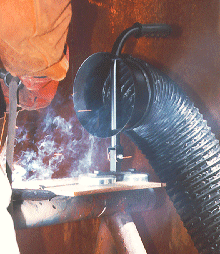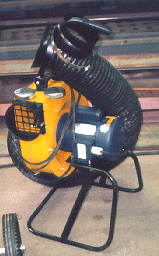Hospitals eTool
Facilities Management » Welding Fumes
Hazards
Maintenance employees may be exposed to welding fumes as they are repairing items. Welding fumes contain particulate matter and gases, which may be a health concern for workers, particularly if welding is performed in confined spaces.
Health Effects
There are numerous health hazards associated with exposure to fumes, gases and infrared radiation formed or released during welding, cutting and brazing. These health hazards include heavy metal poisoning, lung cancer, metal fume fever, and others. Flash burns to skin and eye can also occur. The hazards vary depending upon the type of welding materials used and the surfaces welded. For example, welding fumes are composed of metals, most fumes contain a small percentage of manganese, and the CDC has raised concerns about potential neurological effects associated with exposure to manganese in welding fumes. The International Agency for Research on Cancer (IARC) has classified welding fumes and UV radiation from welding as Group 1 carcinogens, the agency’s designation for agents that carry sufficient evidence of carcinogenicity in humans (IARC).
Requirements under OSHA's Welding, Cutting and Brazing Standard, 29 CFR 1910.252


Follow the requirements of the Welding, Cutting and Brazing Standard:
- Eye Protection. [29 CFR 1910.252(b)(2)]
- Protective clothing. [29 CFR 1910.252(b)(3)]
- Work in confined spaces. [29 CFR 1910.252(b)(4)]
- Local exhaust or general ventilating systems shall be provided and arranged to keep the amount of toxic fumes, gases, or dusts below the maximum allowable concentration as specified in 29 CFR 1910.1000. [29 CFR 1910.252(c)(1)(iii)].
Additional Information
- Welding, Cutting, and Brazing. OSHA Safety and Health Topics Page.
- Controlling Hazardous Fume and Gases during Welding. OSHA Fact Sheet (Publication 3647), (2013).
- Criteria for a Recommended Standard: Welding, Brazing, and Thermal Cutting. U.S. Department of Health and Human Services (DHHS), National Institute for Occupational Safety and Health (NIOSH) Publication No. 88-110, (April 1988). Recommends reducing exposures to all welding emissions to the lowest feasible concentrations using state-of-the-art engineering controls and work practices (e.g., using local exhaust ventilation units to remove fumes).
- Control Technology Assessment for the Welding Operations at Boilermaker's National Apprenticeship Training School, Kansas City, Kansas. National Institute for Occupational Safety and Health (NIOSH) In-Depth Report, (June 27, 1997). Identifies, observes, and evaluates engineering control measures that may reduce the amount of fumes to which a worker is exposed during welding.
- Welding and Manganese: Potential Neurologic Effects. National Institute for Occupational Safety and Health (NIOSH) Workplace Safety and Health Topic.
- General Industry Outreach Training Program. OSHA.
- Safety in Welding, Cutting, and Allied Processes. AWS/ANSI Z49.1:2012. American Welding Society.
- Welding, Molybdenum Trioxide, and Indium Tin Oxide: IARC Monographs on the Evaluation of Carcinogenic Risks to Humans Volume 118. IARC. ISBN-13. 978-92-832-0185-4.

